|
Website: http://www.truevalue.comLevel of difficulty: All Levels

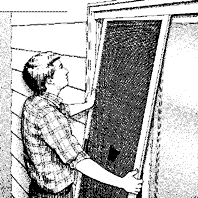
If your sliding screen door is not rolling properly, a few simple repairs will get it back on track. We've also included instruction on how to repair screening.
Which type to use--fiberglass or aluminum? Fiberglass screening will not puncture easily because it stretches. For that reason, it also does not stretch
tightly in the door frame. Aluminum is stronger, and does not get stretched out. It is harder to roll into the groove without tearing it. Before You Begin:
When you're ready to start, lift the screen up and tilt out the bottom. In some cases, you'll have to lift the wheels up and over the track as you pull
the door out. Use a screwdriver. You can do the same to reinstall it; or try the trick shown in Step 11. If you struggle to open and close your sliding
patio door, too, stand inside and lift the sliding panel up and out of the track.
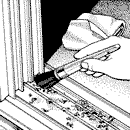 1. Clean
Tracks 1. Clean
Tracks
With the screen door removed, clean the track with a soft brush or vacuum it. The grit not only makes it harder to operate the doors, it causes
the roller to wear prematurely. |
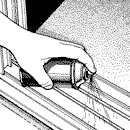 2. Lubricate
Tracks 2. Lubricate
Tracks
Spray a little silicone or Teflon spray lubricant on the tracks and rub them down with fine steel wool. If a track is bent, straighten it by tapping
against it with a block of wood and a hammer. |
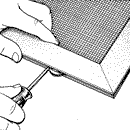 3. Remove
Roller 3. Remove
Roller
If a roller does not move or spin freely, try to remove it. They usually snap in a channel and are freed by prying it from below. However, there
are almost as many designs as there are screen doors--some are riveted and others snap into channels or are held by screws. Don't force anything.
It can be very hard to locate replacement parts. You may also be able to clean it in place using a brush, toothpick, or compressed air. |
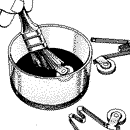 4. Clean
Roller 4. Clean
Roller
Wash the tension spring roller in a grease-cutting detergent/water solution. Dry the parts well and spray them with silicone lubricant before reinstalling
them. If you don't have any screen repairs to make, go to Step 11. |
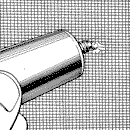 5. Patch
Small Hole 5. Patch
Small Hole
If you have a small hole or tear in your screening, put a dab of clear silicone caulk on it and then smooth it with a finger or plastic spoon.
|
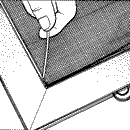 6. Remove
Damaged Screen 6. Remove
Damaged Screen
To replace damaged screen, remove the door and lay it flat on a large worktable or the floor. Find an end of the spline that holds the screen in
its groove and pry it out with a pointed tool. Then pull it out by hand. If it is old or brittle, replace it with identical material. Otherwise
save it for reuse. |
 7. Cut New
Screen 7. Cut New
Screen
Cut the new screen with scissors or a utility knife so it overlaps the groove 1 inch on all sides. Tape it to the door in a few spots on each side.
Trim the screen at a 45-degree angle at one corner to prevent it from bunching up at the corner when it is rolled into the groove. Only cut one
corner at this time. |
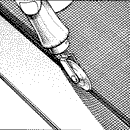 8. Roll
Screen 8. Roll
Screen
Starting at the cut corner lightly roll the screening into the groove. Use the convex side of the screen installation tool and work gently. It tears
easily. If you are using fiberglass screen (not aluminum) you can skip this step and roll the screen and the spline into the groove at the same
time. |
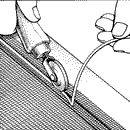 9. Roll
Spline 9. Roll
Spline
Using the concave roller to carefully roll the spline into the groove over the screen. Roll it in just enough to hold and work your way down the
line. Then come back and re-roll to drive it completely down into the groove. Work carefully to avoid slitting the screen and tearing it. With those
two sides nearly done, cut the next two corners and roll in the screen and the spline. Repeat procedure for the last corner. |
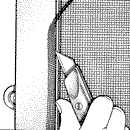 10. Trim
Excess 10. Trim
Excess
Run a sharp utility knife or single-edge razor blade between the spline and the metal frame to cut off excess screening. Reinstall the screen door
by reversing the removal procedure or try the method shown in the next step. |
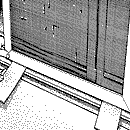 11. Reinstall
Door 11. Reinstall
Door
To keep the rollers up in place until they are positioned over the tracks, lay a couple of thin pieces of cardboard or shingle tips over the tracks
at the roller locations. Slip the top of the door up into the upper channel and push in the bottom. Hold the door with the wheels over the tracks
and slip out the shims one at a time. |
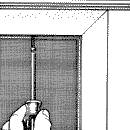 12. Adjust
Roller 12. Adjust
Roller
Most screen door rollers can be adjusted at the top and/or the bottom. The adjustment screw in this one is obvious. On other door the screws are
usually accessed from the edge of the door through an access hole. Turn the screw in or back it out to raise and rower the screen door until the
door frame is up off the track and the door side meets the doorjamb evenly. |
Tools and Materials
- Phillips and standard screwdrivers
- Brush and/or vacuum
- Silicone spray lubricant
- Clear silicone caulk
- Shears or scissors
- Screen installation tool
- Utility knife or single-edge razor
- Blade
- Masking tape
- Replacement screening and spline
|
Note: This article was submitted by a second party and the contents are subject to our disclaimer.
|

